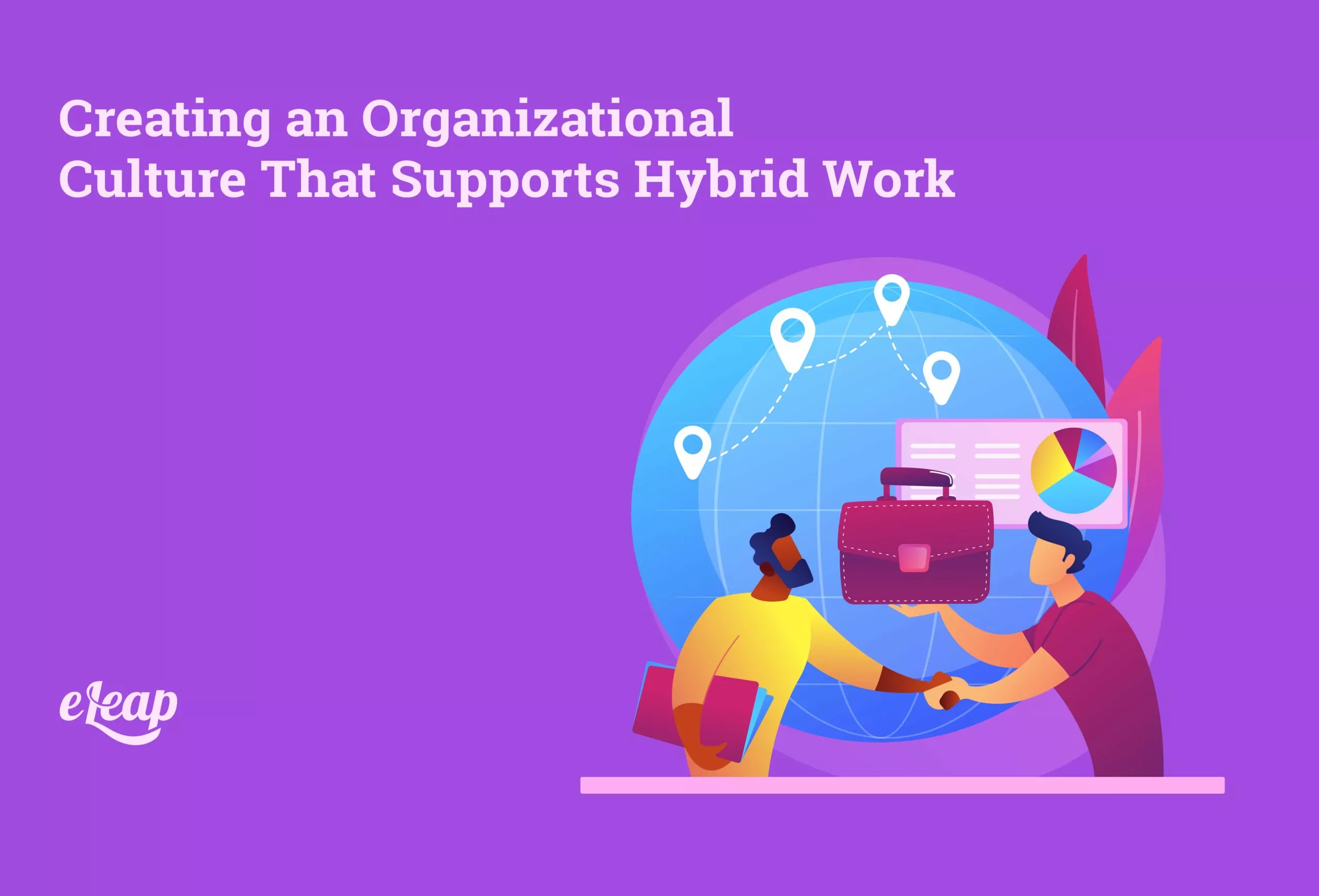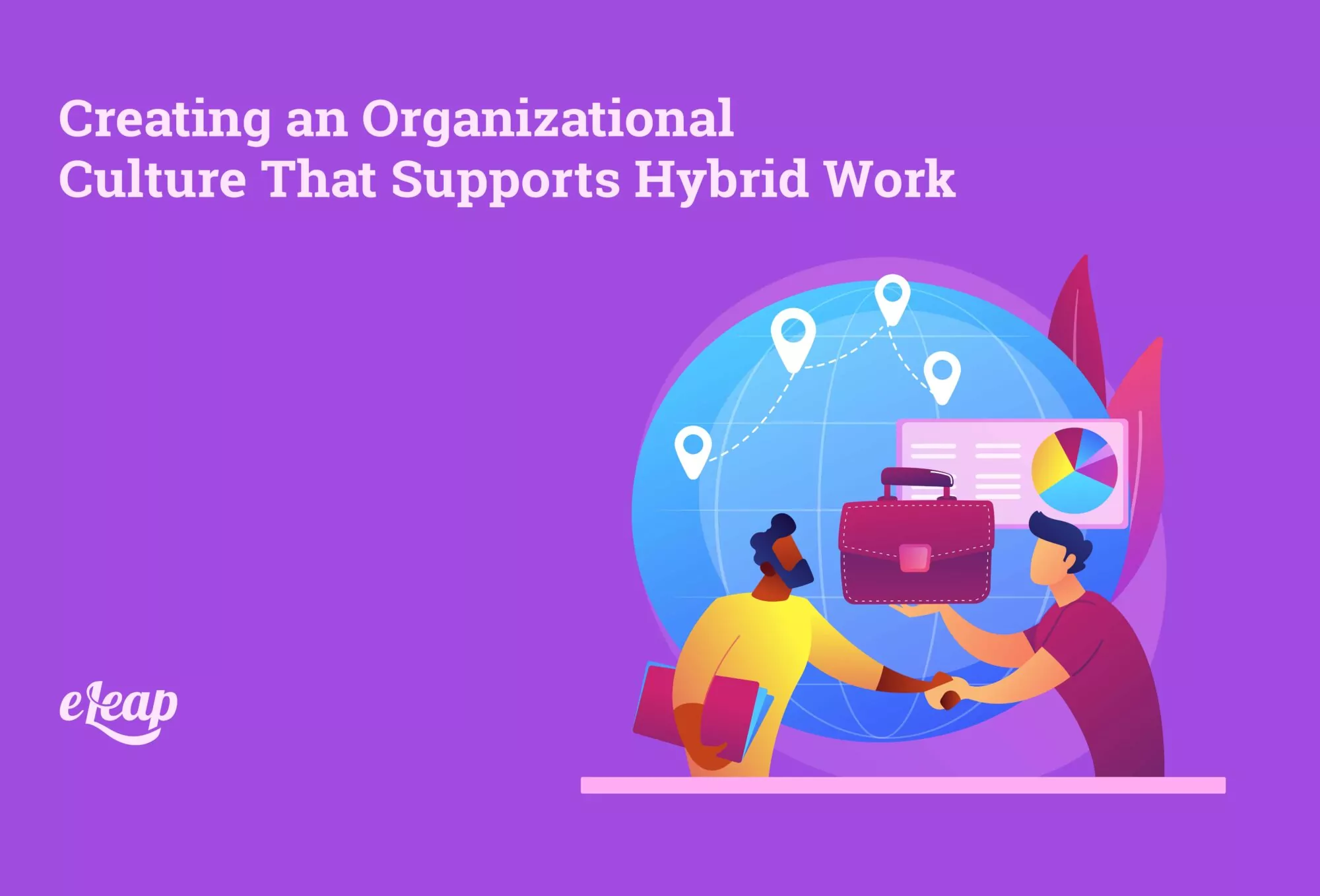Creating an Organizational Culture That Supports Hybrid Work

Everywhere you look, the world is slowly starting to return to normal. Well, something resembling the old normal, at any rate. For most organizations, returning to the office full-time is not only impossible but impractical. They’ve seen the benefits of remote work firsthand. Most employees prefer to remain at home, too, particularly after a year of remote work and reinventing their lives.
However, some business processes are best done in the office. Some employees also thrive better in an in-person environment. To accommodate all those needs, plus ensure social distancing, most organizations are moving to a hybrid work model. That poses some challenges, particularly when it comes to organizational culture.
We’ll show you how to create an organizational culture that supports hybrid work so that employees in the office and those at home can achieve success.

What Is Culture?
When we think about organizational culture, what comes to mind is usually a set of shared behaviors and values. It’s the combination of forces that shape how people work with one another and interact during the day. It can also be seen as a predisposition to behave in a particular way. That’s why there are both positive and negative organizational cultures.
That’s changing, though. More and more organizations are on board with diversity, equity, inclusion, and belonging (DEIB) within the workplace. Company cultures are changing to support those. Those shifts can also support hybrid work.
How Must Culture Evolve to Support Hybrid Work?
To be clear, no organization’s culture will survive the shift from in-office to remote to hybrid completely intact. And that’s a good thing. This is an opportunity to prune unhelpful or unbeneficial policies and practices. It’s a chance to focus on things that help and eliminate those that don’t.
Rethink Policies and Procedures: First, the shift to hybrid work will require some rethinking of policies and procedures. You’ll need to ensure you can support both in-office and remote workers, as well as those who work in the office some days and from home on others. You’ll need to take a deep dive into policies and procedures and let HR examine things with a critical eye.
Virtual Interactions: We’ve learned that virtual interactions offer a much deeper look at team members. You’re able to see into their homes, meet their kids, pets, and spouses, and just build a stronger relationship with them. These interactions should not go away. In fact, they should be incorporated into your in-office interactions. A little creativity is all it takes to envision a team meeting between in-office and remote workers and how everyone can communicate and share ideas freely.
In-Person Events: While virtual interactions have been largely positive, in-person events have been missed. Whether it’s a long team lunch out on Friday, a company picnic, a catered meal in the office, or something else, in-person events help people feel connected in different ways. They also foster better engagement.
Collaboration Outside Your Team: The pandemic has increased connectivity and communication within teams. Chances are good that your teams have never been stronger. However, communication across teams and collaboration between teams is at an all-time low. That will need to change for hybrid work to, well, work.
Within the office, interactions between teams occur organically. You’ll run into Bob from the Blue Team in the break room or encounter Heather from the Red Team as you’re going into a meeting. Those organic meetings foster communication and collaboration. In a hybrid setting, you’ll need to have a strategy that makes cross-team collaboration not just possible but encouraged. Your in-office employees can play key roles there and ensure that they are reaching out to remote workers and that remote employees are collaborating, as well.
Think of the Office as Off-Site: Once upon a time, working remotely was considered “being off-site”. Today, that perception is changing, particularly for organizations seeking to reinvent their culture around hybrid work. Here, the home office is on-site, and work at the office is off-site. That has some pretty interesting benefits. For instance, you can turn office workdays into purpose-specific events, like collaborating on strategy or information sharing.
Incentivize In-Office Work: In the past, most people worked from the office. However, the pandemic has shown us that employees can be wildly productive right at home and that the office environment is largely irrelevant to most people’s job duties. It may become necessary to offer incentives to encourage some people to return to the office on a part-time basis.
Leaders Are Hybrid, Too: Culture starts and stops at the top. It doesn’t matter what HR preaches. If leaders say and do something different, they set the tone for the rest of the organization. That means leaders need to embrace hybrid work and lead from that position themselves.
That could be problematic if the CEO is one of those holdouts who’s pushing to have everyone return to the office for personal reasons and despite the evidence that remote work is both preferable and more productive than in-office work. Leaders must do more than just give lip service to hybrid work, though.
They need to communicate well with in-office and remote employees; they must find new ways to gather information rather than via “management by walking around”. It’s important to find the right tools – surveys, feedback reports, follow-up questions, and more can be used in check-ins and larger meetings to attain the types of insights previously gained by walking around.
It’s a Brand New World
Yes, things are in flux right now. Yes, shifting from in-office to remote to hybrid work models is hard. However, it can be done and with the right focus on culture, it’s possible to come back stronger than you were before the pandemic hit.
However, it does require getting out of your comfort zone. Leaders will need to rethink their insistence on in-office work and find tools and solutions to surface the insights once gained through face-to-face interaction. Still, it’s a brand new world and hybrid work offers benefits unavailable through in-office or remote-only work.